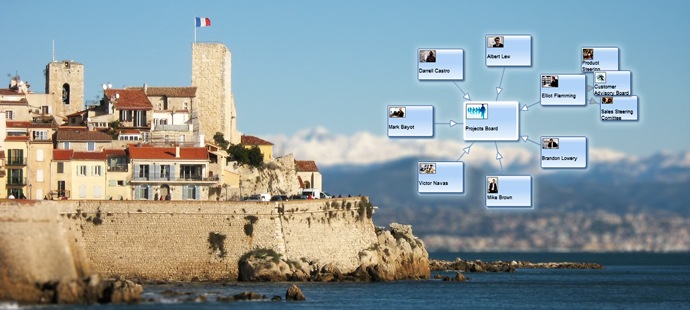France has a plan to put the latest 2.0 technology at the service of its citizens called Le France Numérique 2012. It outlines how the government intends to:
- Provide everybody access to digital networks and services
- Develop and provide new digital services
- Grow the number and usage of digital services by companies, government departments, and individuals
- Modernize the governance of the digital economy
As part of the plan, Nathalie Kosciusko-Morizet, the French Deputy Minister for the Development of the Digital Economy launched a call last spring for innovative web initiatives. One of the selected projects, led by SAP Research, is called ARSA (“Analyse des Réseaux Sociaux pour les Administrations”, social network analysis for government authorities).
The project uses the Social Network Analyzer (SNA) technology from the SAP Business Objects Innovation Center to improve collaboration and government transparency in the public sector, laying the foundations for “Administration 2.0”.
A press conference this morning in SAP’s Paris headquarters hosted by Vincent de Poret outlined the project’s goals. Gilles Logeais, the Research Director for SAP Research France, explained that the two-year, €1.3M project will be carried out in partnership with the town of Antibes on the French Riviera, chosen as a representative mid-sized French town, with around 75,000 inhabitants and a wide variety of public services.
With help from students of the prestigious Ecole Centrale Paris engineering school, and a local cloud computing platform partner, Euclyde, the team will research how best to use social network analysis technology for government departments and local authorities, in order to:
- Optimize collaboration within public-sector organizations
- Improve transparency and convenience for citizens accessing services (who does what)
- Improve the ability of public-sector organizations to understand and react to the needs of citizens (who needs what)

Vincent de Poret, Cedric Ulmer, Alexis Naibo, and Gilles Logeais of SAP
Alexis Naibo of the SAP BusinessObjects Innovation Center gave a demonstration of the SNA technology, explaining how it can import data from a wide variety of sources including internal business applications, corporate databases, and external interfaces. Once the data has been gathered, people can search for experts and discover relationships using an intuitive interface.
Today’s organizations are increasingly complex, with frequent reorganizations and many cross-functional teams and initiatives. The result is that the standard corporate hierarchy, which is often the only relationship information available, rarely reflects how people really work together. Many people today are active members of professional social networks such as LinkedIn or Viadeo, and want it to be as easy to find an internal contact as it is externally.
 SNA has the potential to gives a more complete, 360 degree view of collaboration in the organization, leveraging the knowledge already embedded in corporate applications such as human capital management, customer relationship management, and project management systems.
SNA has the potential to gives a more complete, 360 degree view of collaboration in the organization, leveraging the knowledge already embedded in corporate applications such as human capital management, customer relationship management, and project management systems.
The prototype makes it easy to understand existing relationships between people in much the same way that traditional business intelligence systems help organizations understand data stored in their corporate systems.
Unlike consumer-oriented social network tools that only support one type of relationship between individuals (“I know X”) and a limited, predefined collection of data attributes, SNA supports multiple different types of relationships between both individuals and groups, and organizations can easily adapt and extend the information and links contained in each individual’s profile.
Anything technology that touches on relationships between people requires sensitive handling, and SNA is designed to meet all the technical, legal, and organizational requirements for data security and governance, by incorporating fine-grained control over information access. In addition, the platform is designed to fit seamlessly into existing environments, supporting standards such LDAP and Google’s OpenSocial, and with integration to mobile devices and corporate email accounts.
Alexis explained that the prototype has been implemented as a beta project within SAP and has proved very popular with employees. As a standard part of the internal company portal, all SAP’s approximately 50,000 staff have access to the solution, and it is used thousands of times each week.
An open SNA demonstration is available online for anybody would like to understand the technology, at http://sna-demo.ondemand.com
SAP is still investigating how best to package and commercialize the SNA prototype, but there has been considerable interest from potential customers, notably as a seamless part of specific SAP business vertical and functional applications.
Cedric Ulmer, the research project lead for SAP, explained that town of Antibes, like any other organization, needs to work as efficiently as possible, but as a public organizations must also be as transparent as possible with its citizen customers. The first phase of the project will be to adapt the SNA technology to the town’s particular needs. Cedric cited some applications that might be of interest, such as:
- Understanding the complex links between the local authority and the many different suppliers that compete for public contracts, and the relationship between those different suppliers
- How the local authority can best collaborate with the wide range of different local associations (sporting associations, business groups, etc.) to meet the broader needs of local citizens
Other articles:

Comments
One response to “SAP Innovation: Social Networking at the Service of the French Public Sector”
[…] image adapted from original photo by Valeria Cerutti (Cross-posted @ SAP Web 2.0)Posted Under : Enterprise Tags Social Networking SAP All Web 2.0 by SAP BusinessObjects Innovation […]